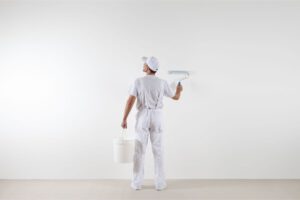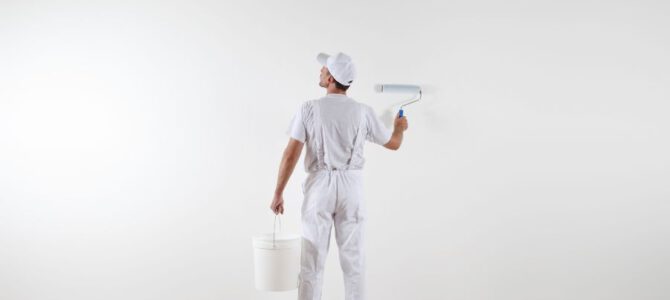Interior Painters Perth is more than someone who recolors your walls. They provide insight, advice, and quality work that will raise the value of your home and make it feel more inviting.
Before painting, your contractor will most likely do a walk-through of the space to address any repairs and determine what is needed to complete the job. Then, they will give you an estimate for the direct and indirect costs.

When a painter is working on a room in your home, the workspace must be clear. Furniture should be moved to another part of the house and any decorative items, such as clocks, mirrors, and wall hangings should be removed. This allows the painters to move about the room without worrying about hitting anything or creating an uneven surface. It also helps them avoid obstructing the painting area with large pieces of furniture or getting paint on their personal belongings.
A professional interior painter will have a full vision of what they are doing and will plan accordingly. They will do a walk-through with you and ask lots of questions to ensure they understand exactly what you want. They should be able to provide you with a quote for the project, and this will include all direct costs (paint, labor, and gas). It should also have a breakdown of all indirect expenses and any potential additional fees or charges.
Before beginning work, a professional will do a complete walk-through and make notes of any areas that may need special attention or aren’t as good as they should be. They will also talk to you about your preferred color and texture options, as well as any other details specific to the job. They will then make on-site preparations, such as building scaffolding and covering fixtures to protect them from falling/dripping/spilled paint.
Depending on the size of your home, a professional might have to rent or purchase tools to do their job. They will have to pay for materials, such as brushes, rollers, tape, and drop cloths. They might need to get permission from you or the landlord to use a ladder in your home, as well. It’s important that you prepare your space before the painters arrive, as this will help them do their job more efficiently and give you a better result. It’s also important that you choose a qualified professional with plenty of experience and a solid track record of satisfied customers. This will help reduce your stress and risk of having to redo the entire job in a few months, or even worse, find yourself with a sub-par finish that you’ll be forced to live with for years to come.
Professional painters are skilled at painting interior surfaces, and will use a variety of brushes, rollers, and sprayers to create a smooth finish. They also know how many coats of paint are required and the proper time to let each coat dry between applications. They will have a wide selection of colors available, including popular neutrals like beige and gray. They will also have a good understanding of the latest home design trends.
They will take a thorough walk-through of your house and may make some measurements to help them get an accurate price estimate. Then, they will be able to provide you with a detailed written quote that will outline all direct and indirect costs. Direct costs include the cost of the materials, including paint, brushes, and other tools, as well as labor. Indirect costs are things like monthly payments on equipment and work trucks, overhead expenses, and a portion of the painter’s salary.
Most paint contractors will have a full crew of employees working on your project, and can usually complete a room in a fraction of the time that you could do it yourself. This can save you a lot of time and stress, as well as giving your home an updated look that will impress guests.
In addition to the actual painting, professional painters will probably have someone handling prep work and another person responsible for cleaning up. This helps to keep the job running smoothly and minimizes any inconvenience to you. They will typically have a good idea of how long the job will take and will keep you apprised of their progress throughout the process.
Interior painting is one of the best ways to spruce up your home and can add significant value to it. It can also help to protect your walls from physical and environmental damage, such as scratches, scuffs, humidity, and moisture. It’s one of the few remodeling projects that has consistently shown high returns on investment. With so much at stake, you should only trust your home’s interior to the professionals. If you’re looking for an experienced, reliable, and affordable interior painter, contact the team at . We’ll provide you with a free quote on your next project.
An interior painter must be able to do touch-ups or cover up small imperfections on walls after a painting project is complete. These may include scuff marks, blemishes, or overspray from the spray applicator. The goal is to make the touch-up as seamless and invisible as possible to achieve a finished look.
Before doing a touch-up, the surface must be cleaned thoroughly to remove any dirt and debris. Then, the surface should be primed. Primer is essential to ensure that the touch-up will blend with the existing paint color. A good primer will also help to create a consistent surface texture and prevent the new paint from chipping. After priming, the spot should be covered with a thin coat of the same interior latex paint that was used for the original painting. Using the same application tool—either a brush or roller—is important to maintain the wall’s texture and inconspicuousness. The painter must also feather the touch-up slightly into the surrounding area to avoid a noticeable blob. After applying the touch-up, it is important to inspect it in natural and artificial light at all times of day. This will allow the interior painter to see whether the touch-up is visible and if it needs further work or hiding.
Achieving a flawless and inconspicuous touch-up is not always possible, but a professional painter should be able to conceal most imperfections with minimal effort. The key to a successful touch-up is the same paint that was used for the original application, along with the same application technique, equipment loading, pressure, and direction of lay-off.
Touch-ups are an important part of a successful paint job, and they can save homeowners money by preventing the need for a full repainting job in the future. A professional interior painter will use proper preparation techniques, a high-quality paint, and the correct tools for the job to achieve a flawless finish. They will also be able to perform touch-ups efficiently and effectively to save time for the customer. To ensure a great result, it is important to hire a professional with prior experience and an excellent reputation.
Cleaning the walls is a critical step in any painting job. This is because it helps the new paint adhere to the surface. It also removes any oils that may interfere with a new coat of paint. During this process, a painter can use a sponge or a soft-bristled brush. They may also use a mild degreaser or sugar soap on more stubborn stains.
During the washing process, it is important for painters to wear rubber gloves. This is to protect their hands from harsh chemicals and possible discoloration. They should also use a mild detergent to wash the walls. A few drops of liquid dish soap mixed with lukewarm water is an effective cleaning solution for most walls. However, the cleaning solution should not come into contact with outlets or other areas that may be live.
Once the walls are clean, they should be wiped down with a damp cloth to ensure that all areas are dry and ready for a new coat of paint. In addition, a few light sanding strokes should be used to smooth rough surfaces and to slough off sticky dirt particles. A light sanding also helps to degloss surfaces and reduce the stippling that often occurs with old painted surfaces.
The painters should then apply caulk or putty to any cracks in the wall surface. This will help to keep moisture from seeping through the new paint and causing damage to other materials in the room. They should also use painter’s tape to mask off areas that are not part of the painting project. This is to prevent paint from squeezing into or around items such as woodwork, molding, trim and electrical outlets.
While it is not necessary for professional painters to wash the walls prior to painting, they understand the importance of having a clean surface and will typically take the time to prepare your walls properly for an exceptional paint job. They will clean and prep the wall surface, patch holes and cracks, apply a priming coat and finally wash the walls before they start the painting process. This attention to detail will ensure that your paint job will last for years to come.
